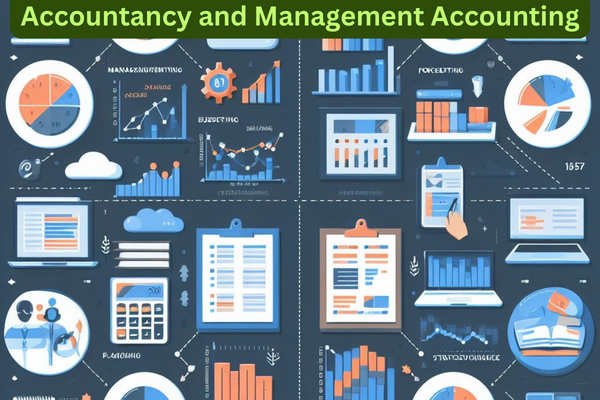Contents
- 1 Introduction of Accountancy and Management Accounting
- 2 Defining Accountancy
- 3 Key Functions of Accountancy
- 4 Who Benefits from Accountancy?
- 5 Decoding Management Accounting
- 6 Key Functions of Management Accounting
- 7 Who Benefits from Management Accounting?
- 8 Bridging the Gap: Overlapping Aspects
- 9 While distinct, accountancy and administration accounting share the frequent floor in positive areas.
- 10 Choosing the Right Path: When to Use Which
Introduction of Accountancy and Management Accounting
In the realm of finance, two phrases regularly surface—accountancy and management accounting. While they may appear interchangeable, they play wonderful roles in the monetary ecosystem. In this complete guide, we will unravel the intricacies of both, shedding mild on their special traits and the pivotal function every performs in guiding the monetary ship.
Defining Accountancy
Accountancy, regularly referred to as monetary accounting, is the bedrock of monetary record-keeping. It entails the systematic recording, summarizing, and inspecting of economic transactions of an entity. The foremost intention of accountancy is to supply stakeholders—both inner and external—with a clear, obvious view of the monetary fitness of an organization.
Key Functions of Accountancy
1. Bookkeeping:
At the core of accountancy lies bookkeeping, the place where each economic transaction is meticulously recorded. This method ensures a certain historical document of an entity’s monetary activities.
2. Financial Statements:
Accountancy culminates in the advent of economic statements—balance sheets, earnings statements, and money go-with-the-flow statements. These files provide an image of an organization’s economic standing at a unique factor in time.
3. Compliance:
Accountancy ensures that economic files adhere to mounted accounting standards and comply with regulatory standards. This is integral for constructing belief amongst stakeholders and pleasing prison requirements.
Who Benefits from Accountancy?
1. External Stakeholders:
Investors, creditors, and regulatory bodies count the number on economic statements organized via accountancy to make knowledgeable decisions.
2. Tax Authorities:
Accurate economic information resource in finding out tax liabilities and making sure compliance with tax regulations.
Decoding Management Accounting
Unlike accountancy, administration accounting is an interior function. It focuses on offering data to the administration for strategic decision-making and planning. Management accountants are like economic detectives, delving into facts to resource inner stakeholders in optimizing operations and accomplishing organizational goals.
Key Functions of Management Accounting
1. Budgeting:
Management accounting entails growing budgets, assisting agencies to allocate sources correctly, and formatting for future economic endeavours.
2. Performance Analysis:
Through variance evaluation and different tools, administration accountants evaluate the overall performance of one-of-a-kind departments or projects, helping the administration in making changes to decorate efficiency.
3. Forecasting:
Anticipating future tendencies and economic effects is a vital element of administration accounting. This helps agencies adapt to adjustments and make proactive decisions.
Who Benefits from Management Accounting?
1. Internal Stakeholders:
Management accounting mainly serves inner decision-makers, which include executives, branch heads, and operational managers.
2. Strategic Planners:
Organizations use administration accounting to formulate strategies, set goals, and determine the economic feasibility of several guides of action.
Bridging the Gap: Overlapping Aspects
1. Financial Reporting:
Both disciplines contribute to economic reporting, albeit for exceptional audiences. Accountancy focuses on exterior reporting for buyers and regulators, whilst administration accounting affords internally focused reviews for strategic planning.
2. Data Integrity:
Both fields emphasize the significance of correct and dependable economic data. Without dependable data, the insights furnished by using self-discipline would be compromised.
Choosing the Right Path: When to Use Which
The choice to appoint accountancy or administration accounting—or both—depends on the particular wants of an organization.
1. When to opt for Accountancy:
External Reporting Requirements: If an agency wishes to comply with regulatory requirements and furnish obvious economic statistics to exterior parties, accountancy is indispensable.
Historical Analysis: Accountancy is well-suited for inspecting previous monetary overall performance and developing a historic record.
2. When to Embrace Management Accounting:
Internal Decision-Making Needs: When the focal point is on optimizing inner processes, putting budgets, and making strategic decisions, administration accounting comes to the forefront.
3. Future Planning:
For agencies searching to forecast and layout for the future, administration accounting affords the imperative equipment and insights.
Conclusion
In the tremendous panorama of finance, accountancy, and administration accounting stands as a pillar, helping wonderful sides of an organization’s economic journey. Accountancy, with its exterior focus, ensures transparency and compliance, catering to the wishes of traders and regulators. On the other hand, administration accounting operates internally, guiding strategic decisions, optimizing processes, and steerage businesses towards their goals. Both are indispensable, and the key to monetary success lies in grasping when to appoint each, or sometimes, both, to navigate the complicated seas of modern-day finance.

Leave a Reply